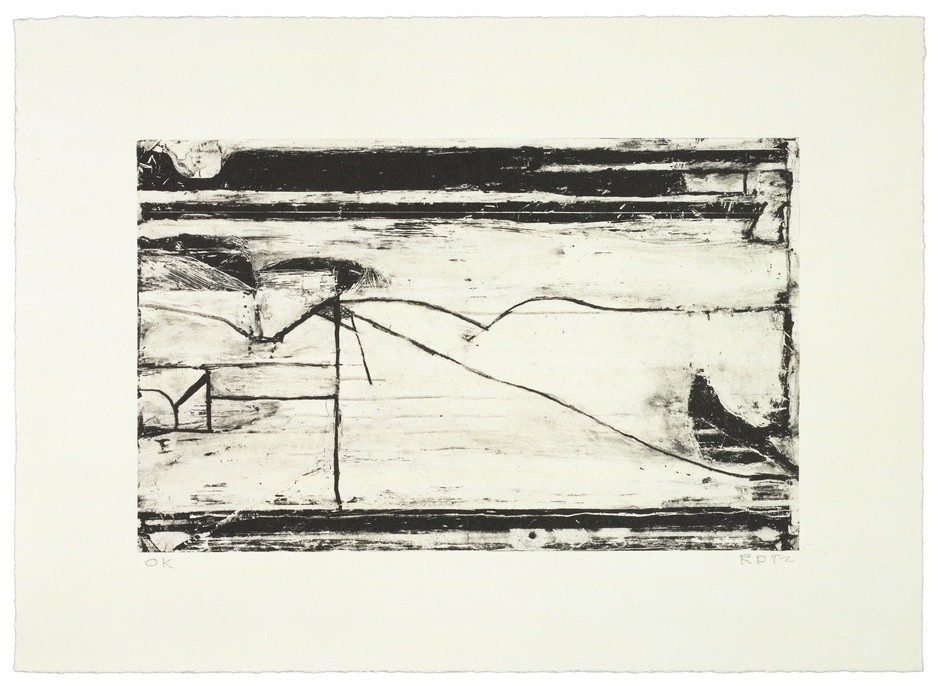
Richard Diebenkorn: The 1993 Portfolio
Gemini G.E.L. is pleased to present Richard Diebenkorn: The 1993 Portfolio, an exhibition showcasing the artist’s final body of lithographs, opening Thursday, May 29, 2025, with a public reception from 5:00 to 8:00 PM. The exhibition coincides with the release of Richard Diebenkorn: The Catalogue Raisonné of Prints, a landmark twovolume publication documenting the artist’s complete print oeuvre of over 400 prints spanning five decades, which includes collaborations with Crown Point Press, Tamarind, Gemini G.E.L., and others.
The exhibition features a series of ten untitled lithographs published in 1993, created during Diebenkorn’s final collaboration with Gemini G.E.L. The prints are rendered in a palette of soft blacks and velvety grays, composed of subtle lines, tonal washes, and abstracted forms. Many of the images evolved over multiple stages, as the artist reworked the Mylar sheets with additions and subtractions resulting in several editioned states. Eight of these works were originally issued together as a print portfolio and accompanied by two essays, one by Gemini G.E.L. co-founder Sidney Felsen and the other by workshop manager James Reid. The essays reflect on the unique, long-distance collaboration on the project during the last months of Diebenkorn’s life.
In 1992, Richard Diebenkorn was living in Healdsburg, California, with his wife Phyllis, and reached out to Gemini with a proposal for a new print project. Due to declining health, he was unable to travel to Los Angeles, so he initiated a remote process. Drawing on Mylar sheets in his home studio, Diebenkorn would mail the layered drawings to Gemini, where the team of printers led by Reid would translate them into printing plates, create multiple proofs, and send them back for review. These Mylars were often altered, returned, and reprocessed, which mirrored the artist’s own painting methods, and revealed a profound collaboration between the artist and printmakers.
The mail-based exchange continued through the end of Diebenkorn’s life, resulting in ten editioned prints—two signed by the artist, and eight posthumously issued with an estate stamp approved by his widow, Phyllis Diebenkorn. On view in the exhibition will be a selection of original Mylars, working proofs, and correspondence letters on loan from the Richard Diebenkorn Foundation. These materials offer an intimate view into Diebenkorn’s process and document the often rare, long-distance collaboration that remained dynamic and full of invention until the very end.
Born in Portland, Oregon in 1922 and raised in San Francisco, Richard Diebenkorn is recognized as one of the most influential American painters and printmakers of the postwar era. A dedicated printmaker since the 1960s, Diebenkorn worked with major presses including Crown Point, Tamarind, and Gemini G.E.L. In his final years, he lived and worked in Healdsburg and later Berkeley, where he died in 1993.
His work has been widely exhibited in institutions across the U.S., which include the Palace of the Legion of Honor, San Francisco (1948); the San Francisco Museum of Modern Art (1954); the Pasadena Art Museum (1960); the M.H. de Young Memorial Museum, San Francisco (1963); the Washington Gallery of Modern Art, Washington D.C. (1964); Nelson-Atkins Museum of Art, Kansas City (1968); the Los Angeles County Museum of Art (1969); the Albright-Knox Gallery, Buffalo (1976); and the University of California Art Museum, Santa Barbara (1979)